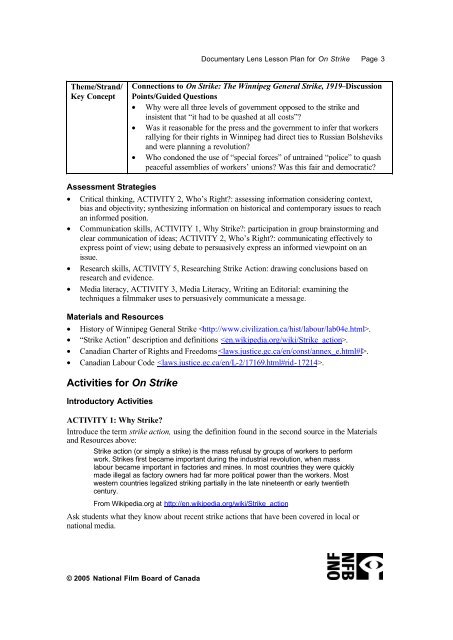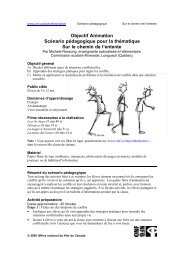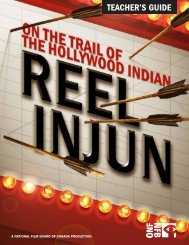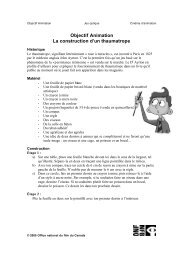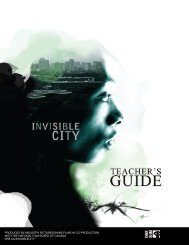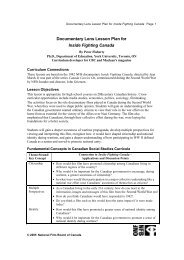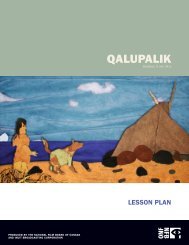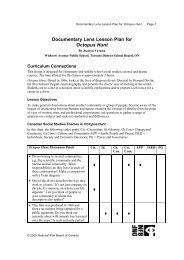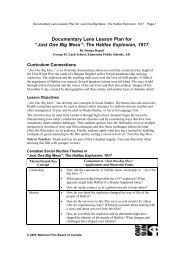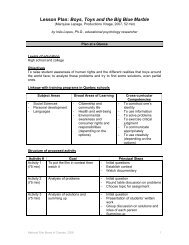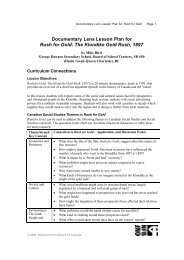Documentary Lens Lesson Plan for On Strike - Office national du film ...
Documentary Lens Lesson Plan for On Strike - Office national du film ...
Documentary Lens Lesson Plan for On Strike - Office national du film ...
You also want an ePaper? Increase the reach of your titles
YUMPU automatically turns print PDFs into web optimized ePapers that Google loves.
<strong>Documentary</strong> <strong>Lens</strong> <strong>Lesson</strong> <strong>Plan</strong> <strong>for</strong> <strong>On</strong> <strong>Strike</strong> Page 3Theme/Strand/Key ConceptConnections to <strong>On</strong> <strong>Strike</strong>: The Winnipeg General <strong>Strike</strong>, 1919–DiscussionPoints/Guided Questions• Why were all three levels of government opposed to the strike andinsistent that “it had to be quashed at all costs”?• Was it reasonable <strong>for</strong> the press and the government to infer that workersrallying <strong>for</strong> their rights in Winnipeg had direct ties to Russian Bolsheviksand were planning a revolution?• Who condoned the use of “special <strong>for</strong>ces” of untrained “police” to quashpeaceful assemblies of workers’ unions? Was this fair and democratic?Assessment Strategies• Critical thinking, ACTIVITY 2, Who’s Right?: assessing in<strong>for</strong>mation considering context,bias and objectivity; synthesizing in<strong>for</strong>mation on historical and contemporary issues to reachan in<strong>for</strong>med position.• Communication skills, ACTIVITY 1, Why <strong>Strike</strong>?: participation in group brainstorming andclear communication of ideas; ACTIVITY 2, Who’s Right?: communicating effectively toexpress point of view; using debate to persuasively express an in<strong>for</strong>med viewpoint on anissue.• Research skills, ACTIVITY 5, Researching <strong>Strike</strong> Action: drawing conclusions based onresearch and evidence.• Media literacy, ACTIVITY 3, Media Literacy, Writing an Editorial: examining thetechniques a <strong>film</strong>maker uses to persuasively communicate a message.Materials and Resources• History of Winnipeg General <strong>Strike</strong> .• “<strong>Strike</strong> Action” description and definitions .• Canadian Charter of Rights and Freedoms .• Canadian Labour Code .Activities <strong>for</strong> <strong>On</strong> <strong>Strike</strong>Intro<strong>du</strong>ctory ActivitiesACTIVITY 1: Why <strong>Strike</strong>?Intro<strong>du</strong>ce the term strike action, using the definition found in the second source in the Materialsand Resources above:<strong>Strike</strong> action (or simply a strike) is the mass refusal by groups of workers to per<strong>for</strong>mwork. <strong>Strike</strong>s first became important <strong>du</strong>ring the in<strong>du</strong>strial revolution, when masslabour became important in factories and mines. In most countries they were quicklymade illegal as factory owners had far more political power than the workers. Mostwestern countries legalized striking partially in the late nineteenth or early twentiethcentury.From Wikipedia.org at http://en.wikipedia.org/wiki/<strong>Strike</strong>_actionAsk students what they know about recent strike actions that have been covered in local or<strong>national</strong> media.© 2005 National Film Board of Canada


